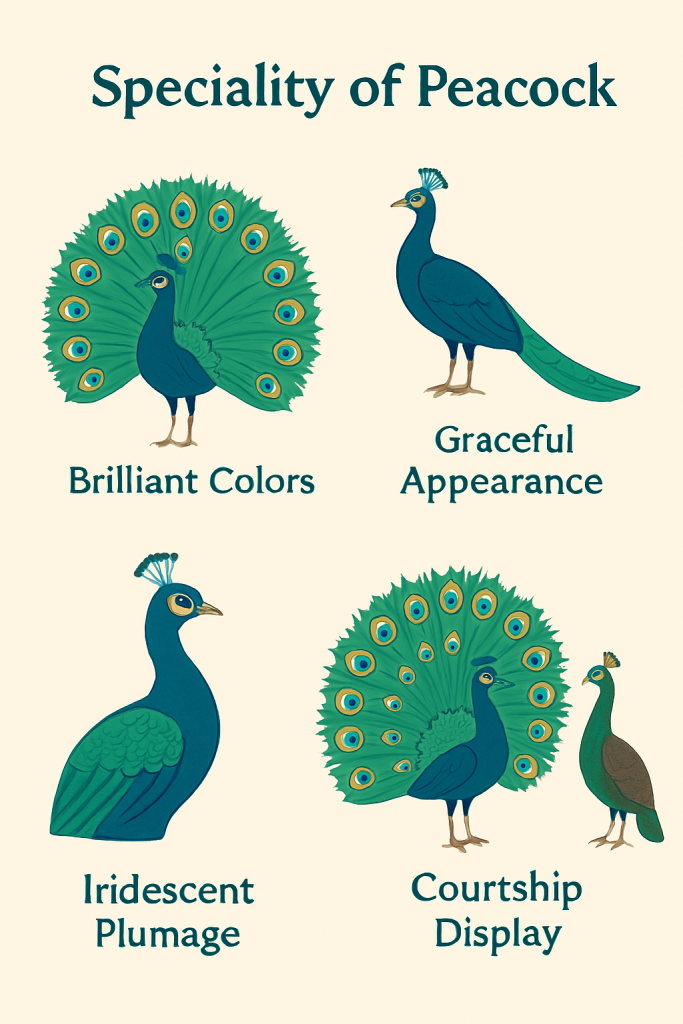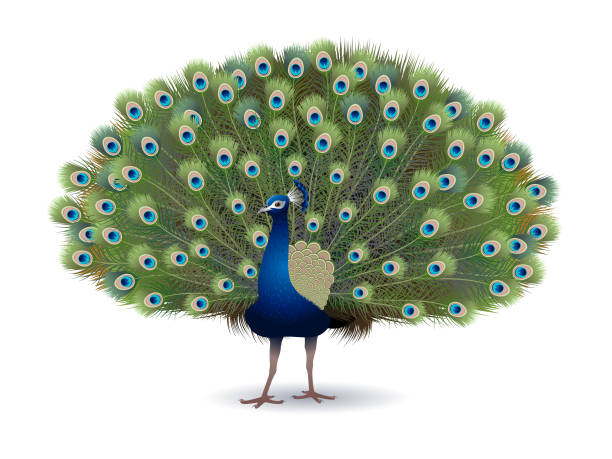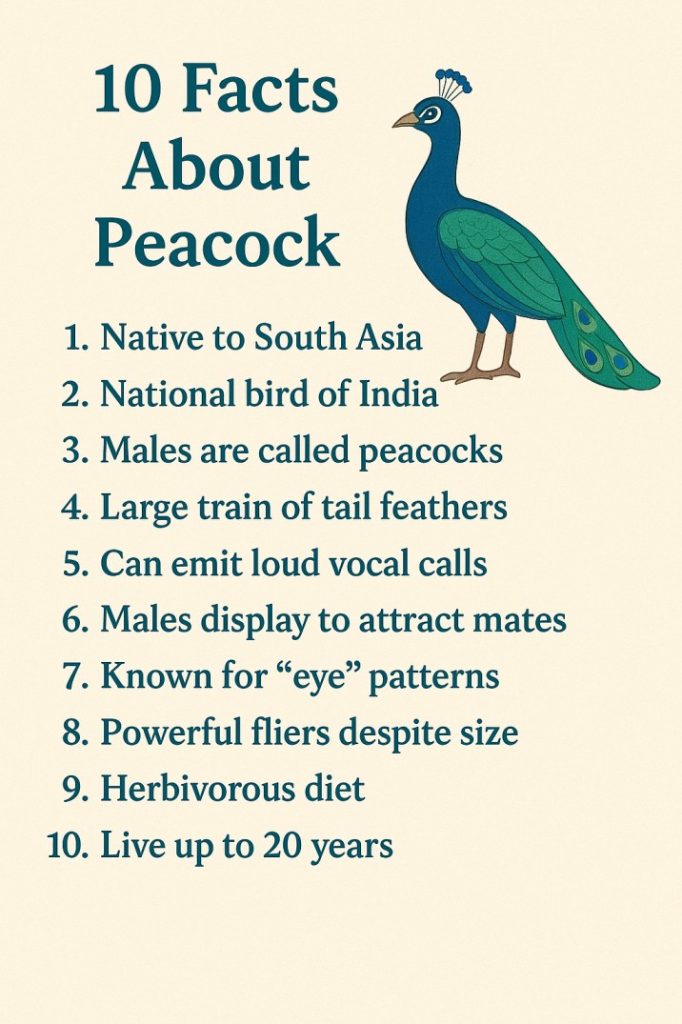Speciality of Peacock: The peacock, scientifically known as Pavo cristatus, is one of the most magnificent birds in the world, renowned for its iridescent plumage and majestic tail feathers. Native to South Asia, this bird symbolizes beauty, grace, and vibrancy in various cultures. The male peacock, with its extravagant tail display, is a visual spectacle, often associated with royalty and divinity. Its striking colors and unique courtship dance make it a subject of fascination for bird enthusiasts, photographers, and researchers alike.

Peacocks belong to the pheasant family and are among the largest flying birds. Their speciality of peacock lies in their dazzling feathers, which exhibit a mesmerizing mix of blue, green, and gold hues. These feathers are not just for show—they play a crucial role in mating rituals, where males fan out their tails to attract females. Beyond their beauty, peacocks have a distinct call and are known for their adaptability to various habitats, from forests to grasslands.
What is the significance of peacock?
The peacock’s significance extends beyond its physical attributes. In Hinduism, it is the mount of Lord Kartikeya and a symbol of integrity and immortality. In many cultures, its feathers are considered auspicious and are used in art and decoration. Whether admired for their ecological role or cultural importance, peacocks remain one of nature’s most extraordinary creations, embodying elegance and splendor.
Spiritual Significance of Peacocks
- Symbol of Immortality – In Greek mythology, the peacock’s “thousand-eyed” feathers represent the all-seeing stars and eternal life.
- Sacred in Hinduism – The peacock is the mount (vahana) of Lord Kartikeya (god of war) and symbolizes wisdom, purity, and protection.
- Associated with Lakshmi & Saraswati – Its feathers are linked to Goddess Lakshmi (prosperity) and Goddess Saraswati (knowledge).
- Christian Symbolism – The peacock’s shedding & regrowth of feathers symbolize resurrection and renewal in early Christian art.
- Guardian Against Evil – In Buddhism, peacock feathers are believed to absorb negative energy and ward off harm.
- Persian Royalty & Divinity – Ancient Persians saw the peacock as a celestial bird, associating it with the Tree of Life.
- Native American Spirituality – Some tribes view the peacock as a messenger of vision, clarity, and spiritual awakening.
- Chinese Feng Shui – Peacock imagery attracts good luck, beauty, and career success when placed in homes or offices.
- Alchemy & Enlightenment – In esoteric traditions, the peacock’s iridescent colors represent the transformation of the soul.
- Universal Symbol of Beauty & Pride – Across cultures, the peacock embodies divine grace, self-confidence, and spiritual awakening.
Key Takeaways
- Peacocks are known for their stunning, iridescent feathers and elaborate courtship displays.
- The male peacock’s tail, called a “train,” is used to attract females during mating.
- Peafowls (the term for both males and females) are native to South Asia but have been introduced worldwide.
- They hold cultural and religious significance in many traditions, especially in Hinduism.
- Peacocks adapt well to various habitats, including forests, farms, and grasslands.
The Significance of Peacock in Hinduism
The speciality of peacock holds a sacred and multifaceted role in Hinduism, symbolizing divinity, protection, wisdom, and cosmic beauty. Revered in scriptures, folklore, and temple iconography, this majestic bird is deeply intertwined with Hindu deities and spiritual teachings.

Vehicle of Lord Kartikeya
- The peacock serves as the vahana (divine mount) of Lord Kartikeya (Murugan), the god of war and victory.
- Kartikeya rides the peacock, symbolizing the conquest over ego (the peacock’s pride) and destructive tendencies.
- The bird’s ability to tread on snakes (a symbol of evil) reflects Kartikeya’s role as a destroyer of negativity.
Association with Lord Krishna
- Lord Krishna adorns his crown with peacock feathers, representing divine love and joy.
- The feathers’ iridescent colors mirror Krishna’s cosmic play (Leela) and the illusion (Maya) of the material world.
- In the Rasa Leela, peacocks dance ecstatically to Krishna’s flute, symbolizing harmony with nature.
Symbol of Goddess Saraswati & Lakshmi
- Peacock feathers are offered to Goddess Saraswati (wisdom) and Goddess Lakshmi (prosperity).
- The bird’s radiant plumage embodies the splendor of knowledge (Vidya) and spiritual wealth.
- In South India, peacock motifs adorn temple ceilings as a blessing for artistic and intellectual growth.
Representation of Integrity & Immortality
- The peacock’s indestructible feathers (mythically immune to poison) signify resilience and purity.
- Its annual shedding and regrowth of feathers parallel the cycle of rebirth (samsara) in Hindu philosophy.
- In the Vishnu Purana, the peacock’s dance heralds rain, linking it to fertility and life’s renewal.
Folk Beliefs & Rituals
- Peacock feathers are used in yagnas (fire rituals) to purify spaces and ward off evil.
- Keeping feathers at home is believed to neutralize negative energy (as per Vastu Shastra).
- In rural traditions, spotting a peacock is considered auspicious, signaling good fortune.
6. Mythological Tales
- The Peacock’s Curse: Legend says the peacock was once a plain bird until Lord Indra blessed it with dazzling feathers for sheltering him from Ravana.
- Mayura (Peacock) in Ramayana: Sita is said to have been protected by peacocks during her exile.
The Anatomy of a Peacock
Vibrant Feathers and Plumage
Peacock feathers are their most distinctive feature, displaying a mix of blue, green, and gold hues. The male’s tail feathers, or “train,” can reach up to 6 feet long and are adorned with eye-like patterns called ocelli. These feathers are not just for beauty—they play a key role in mating displays.
- Iridescent colors due to microscopic crystal-like structures.
- Feathers shed and regrow annually after the breeding season.
- Used in art, fashion, and religious ceremonies.
Peacock Symbolism in Islam: Divine Beauty, Protection, and Spiritual Lessons
The peacock holds a unique place in Islamic tradition, weaving together themes of divine beauty, temptation, and spiritual vigilance. While not as prominently featured as in Hinduism or Persian mythology, its symbolism appears in Hadith commentaries, Sufi teachings, and cultural folklore, offering layered interpretations.
The Peacock in Islamic Creation Narratives
- Guardian of Paradise: Some Islamic traditions suggest that the peacock was once the celestial guardian of Paradise alongside the serpent.
- Symbol of Vanity & Fall: A Hadith commentary (Tafsir al-Tabari) mentions that Iblis (Shaytan) used the peacock to sneak into Eden, leading to its association with deception and worldly allure.
- Loss of Heavenly Voice: Legends say the peacock once had a beautiful voice but lost it after the Fall, leaving only its stunning plumage as a reminder of divine beauty.
Sufi Interpretations: Beauty with a Warning
- Metaphor for the Ego (Nafs): The peacock’s pride in its feathers symbolizes the dangers of arrogance and self-admiration—a core theme in Sufi asceticism.
- Rumi’s Teachings: The poet Jalaluddin Rumi used the peacock as a metaphor for the soul’s journey—its radiant feathers represent spiritual potential, while its feet (touching the earth) remind believers to stay humble.
Cultural and Artistic Symbolism
- Ottoman & Mughal Art: Peacock motifs adorned mosques, palaces, and manuscripts, symbolizing immortality and divine light. The “Peacock Throne” of Shah Jahan reflected celestial glory.
- Protective Talismans: In some Muslim cultures, peacock feathers were believed to ward off the evil eye (Nazar), though scholars debated their permissibility.
Contrast with Hindu & Persian Symbolism
Unlike Hinduism’s purely auspicious view, Islam’s peacock embodies a duality:
| Aspect | Positive Symbolism | Cautionary Symbolism |
|---|---|---|
| Feathers | Divine creation’s beauty | Vanity, temptation (Iblis) |
| Voice | Lost purity (Hadith narratives) | Silence as humility |
| Role in Art | Heavenly splendor | Memento of earthly distractions |
Modern Interpretations & Debates
- Permissibility in Islam: Some scholars discourage keeping peacock feathers due to their link to pre-Islamic myths, while others see them as neutral symbols of nature’s marvels.
- Ecological Lessons: The peacock’s role in ecosystems (pest control, seed dispersal) aligns with the Quranic emphasis on stewardship of nature (Khalifa).
Differences Between Males and Females
| Feature | Male (Peacock) | Female (Peahen) |
|---|---|---|
| Colour | Bright blue & green | Dull brown & grey |
| Tail Feathers | Long, elaborate | Short, plain |
| Size | Larger (3.5-4.5 ft) | Smaller (2.5-3 ft) |
| Role in Mating | Displays to attract mates | Chooses the best male |
Habitat and Distribution
Natural Habitat of Peafowls
Peafowls thrive in forests, grasslands, and near water bodies. They prefer warm climates and are commonly found in:
- India, Sri Lanka, and Southeast Asia (native regions).
- Introduced in the USA, Europe, and Australia.
Adaptability to Different Environments
- Can live in wild and domesticated settings.
- Often seen in zoos, parks, and private estates.
Breeding and Mating Behavior
The Mating Dance of Peacocks
Male peacocks perform an elaborate courtship dance, fanning their tails and shaking feathers to attract females.
Key Behaviors:
- Vocal calls to grab attention.
- Feather vibrations create a rustling sound.
- Females select males based on tail size and vibrancy.
Peacock Eggs and Reproduction
- Peahens lay 4-8 eggs per clutch.
- Incubation period: 28-30 days.
- Chicks are precocial (can walk and feed shortly after hatching).
Cultural and Religious Significance
Peacock in Hinduism
- Vehicle of Lord Kartikeya.
- Associated with Goddess Saraswati (wisdom).
- Feathers used in rituals.
Symbolism in Other Cultures
- Greek mythology: Symbol of immortality.
- Christianity: Represents resurrection.
Interesting Facts About Peacocks
- Lifespan: 15-20 years in the wild.
- Diet: Omnivorous (plants, insects, small animals).
- Flight Capability: Can fly short distances.
Amazing Facts About Peacocks

- Only Males Are Called Peacocks – The term “peacock” refers only to males; females are called peahens, and together, they are peafowls.
- Dazzling Tail Feathers – A peacock’s long, colorful tail (called a train) can grow up to 6 feet—longer than its body!
- Feathers Change Color with Light – Their iridescent feathers appear to shift in color due to microscopic light-reflecting crystals.
- They Can’t Fly Far – Despite their large tails, peacocks can fly short distances, usually to escape predators or roost in trees.
- Loud & Distinctive Calls – Peacocks make loud, high-pitched cries, often sounding like “meow” or “help!”
- Symbol of Royalty & Religion – In Hinduism, the peacock is linked to Lord Krishna, and in Greek myth, it represents Hera, the queen of gods.
- Peahens Choose Mates Based on Tail Quality – Females pick males with the brightest, longest, and most symmetrical feathers.
- They Shed Their Tail Feathers Annually – After mating season, peacocks lose their train and regrow it the next year.
- Peacock Feathers Were Once a Luxury Item – In Victorian times, they were used in fashion, hats, and home décor.
- They Have Excellent Eyesight & Hearing – Peacocks can spot predators from far away and are highly alert.
FAQs on the Speciality of Peacock
1. Why do peacocks spread their feathers?
Peacocks fan their feathers to attract females during mating season and to intimidate rivals.
2. What is the difference between a peacock and a peahen?
- Peacock: Male, colorful, long tail.
- Peahen: Female, dull-colored, short tail.
3. How long do peacock feathers grow?
A male’s train can reach 5-6 feet in length.
4. Are peacocks endangered?
No, they are listed as Least Concern by IUCN.
